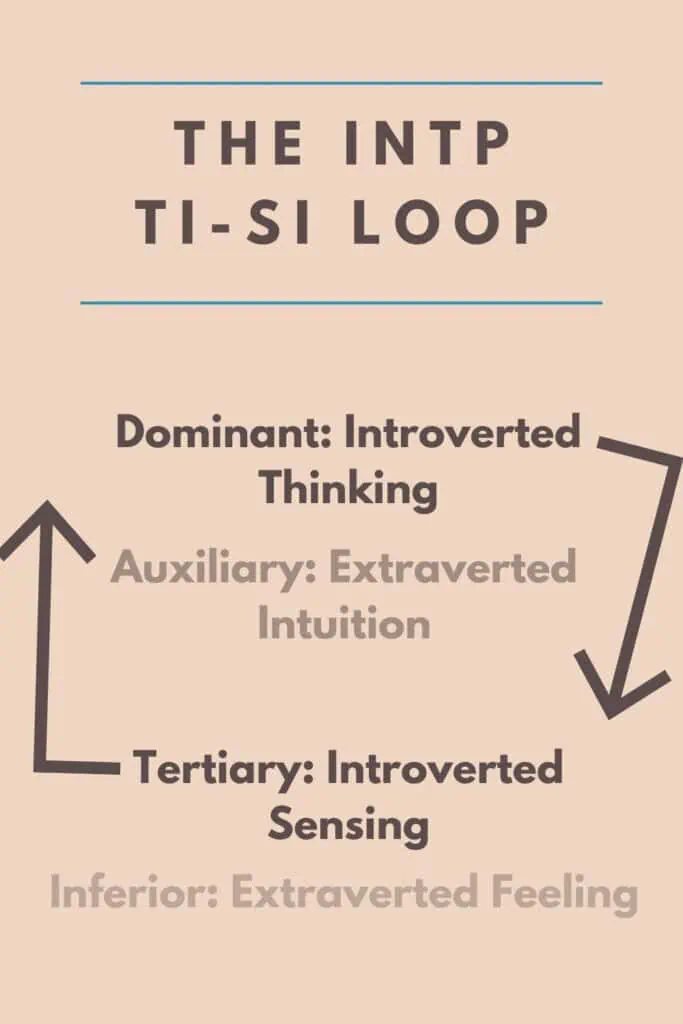The INTP Ti-Si Loop: When Thinking Becomes a Trap
Do you ever find yourself endlessly analyzing every detail of a situation but feeling like you’re getting nowhere? As an INTP, your natural inclination to dissect, scrutinize, and perfect your thoughts is a superpower. But, sometimes, that superpower turns into a trap, especially when you’re stuck in what’s known as a Ti-Si loop. In the world of typology, “looping” refers to a phenomenon where we oscillate between our dominant and tertiary cognitive functions while bypassing our auxiliary and inferior ones.
Not sure what your personality type is? Take our in-depth personality questionnaire here. Or, if you’re feeling fancy, take the official MBTI® test here.

The INTP Ti-Si Loop: When Thinking Becomes a Trap
So, what is a cognitive function stack? You might be shaking your head wondering what in the world auxiliary, dominant, and tertiary functions even are. “These silly typology sites use so much jargon!!” I mean… I feel you. I’ve been there.
A cognitive function stack is essentially the set of mental tools we rely on to process information, make decisions, and interact with the world. Each of the 16 Myers-Briggs personality types has a unique combination of cognitive functions, and for INTPs, this includes Introverted Thinking (Ti), Extraverted Intuition (Ne), Introverted Sensing (Si), and Extraverted Feeling (Fe).
This “stack” dictates how you approach life. Think of it as the toolkit you reach for when solving problems. Some tools get used often (like your trusty Introverted Thinking), while others (like that slightly rusty Extraverted Feeling) get left in the bottom of the box, only pulled out in emergencies (“I mean, do you REALLY have to go to that family reunion?”). The goal is to use all the tools in the stack when needed, but in a loop, you end up favoring a few at the expense of others.
A Deeper Look at the INTP’s Cognitive Functions
Let’s break down the INTP’s cognitive toolbox:
- Introverted Thinking (Ti): This is your dominant function, and it’s what makes you an expert at cutting through the fluff to analyze ideas with precision and depth. Ti helps you develop airtight arguments, sift through data, and strive for real accuracy over “groupthink.”
- Extraverted Intuition (Ne): Your auxiliary function, Extraverted Intuition, is the creative and explorative side of your mind. It’s the reason INTPs love to connect ideas, brainstorm wild concepts, and think about what could be.
- Introverted Sensing (Si): Your tertiary function is where memories, facts, and experiences are stored. Si helps you to reference past experiences to guide present-day decisions.
- Extraverted Feeling (Fe): Last but not least is your inferior function, Extraverted Feeling. This function handles the emotional and social side of life, and as an INTP, it can be tricky for you to access. It’s why you might feel uncertain in emotionally charged situations or when having to cater to social niceties.
But What is the Ti-Si Loop?
The Ti-Si loop happens when INTPs bypass their auxiliary Extraverted Intuition (Ne) and get stuck cycling between their dominant Introverted Thinking (Ti) and their tertiary Introverted Sensing (Si). In this loop, you become overly introspective, using past experiences and stored information to support your internal logic. While that sounds like a good thing at first, it often leads to stagnation, anxiety, and a reluctance to try anything new.
Just look at the handy dandy graphic I made to showcase this process:

Why Does the Ti-Si Loop Happen?
We all have our comfort zones. For an INTP, that zone exists in the world of introversion, especially in the cozy territory of thinking and reflecting. Ti and Si are both introverted functions, so they feed your preference for internal processing. You love introverting. It gives you energy and makes you feel relaxed at the same time, what a cool phenomenon!
However, staying there too long means neglecting your auxiliary Extraverted Intuition (Ne), which helps you explore new ideas and possibilities. And without Ne’s influence, the world can start to feel small, repetitive, and frankly, a bit boring. You might find yourself feeling stuck in a rut, or your theories might seem less grounded in any sort of reality. This is because our extroverted functions are the ones that are interacting with the world around us rather than the world inside of us.
How Do INTPs Feel When They’re in a Loop?
Picture this: You’re sitting at your desk, staring at a problem. You’ve already overanalyzed every possible angle, but instead of moving forward, you’re spiraling, rethinking old ideas and getting stuck in past experiences. This is the Ti-Si loop in action.
I once met an INTP who spent weeks avoiding a big decision because he was fixated on a minor mistake he made five years ago. The past failure was irrelevant to the task at hand, but he couldn’t stop replaying it in his mind. He convinced himself that, unless he could resolve that past failure, he couldn’t move forward with anything else. Classic Ti-Si loop.
When INTPs get caught in this loop, they often:
- Become overly focused on their own thoughts and theories, to the point of ignoring outside input.
- Fall into a pattern of reviewing old data or memories, looking for something they might have missed.
- Hesitate to try new things, preferring the safety of what they already know (even if it’s not working).
- Isolate themselves socially, avoiding interaction or emotional connection.
You might find yourself becoming more withdrawn, skeptical of new ideas, and suspicious of the outside world. Your mind tells you that the past holds all the answers, and you end up missing out on potential new insights that could be found through Extraverted Intuition.
Signs You’re Stuck in a Ti-Si Loop:
- You’re constantly replaying past events, trying to find where things went wrong.
- You’re hypercritical of yourself and hesitant to take risks.
- You’ve become an armchair expert on multiple subjects but struggle to test your ideas in the real world.
- You’ve retreated from social interaction and prefer spending time alone with your thoughts.
- Your day-to-day routine feels repetitive and uninspiring, but you’re reluctant to shake things up.
How to Get Out of a Ti-Si Loop
The key to escaping the Ti-Si loop? Bring your auxiliary Extraverted Intuition (Ne) into the mix. Ne thrives on exploration and novelty, so you need to push yourself outside your comfort zone. It’s time to take some risks, get out in the world, try new things, and open yourself up to new possibilities.
Here’s how to start:
- Change Your Environment: A simple change of scenery can work wonders for Ne. Try going somewhere new—a park, a coffee shop, a museum. The unfamiliar environment will naturally stir up new ideas and perspectives.
- Challenge Your Thinking: Instead of over-analyzing your own thoughts, look for new and different perspectives. Have a debate with someone who disagrees with you. Read about a topic you know nothing about. Allow your ideas to be tested and expanded upon.
- Break Routine: If you’ve fallen into a pattern of predictability, shake things up. Try a new hobby, watch a documentary on a subject you’ve never considered, or even rearrange your workspace. The key is to introduce novelty and creativity.
- Connect with Others: Spend time with people who inspire you to think differently. Extraverted Intuition thrives in the company of others, especially in brainstorming or creative discussions.
- Take Small Risks: If big changes feel overwhelming, start small. Try something you wouldn’t normally do, even if it’s as simple as ordering a new dish at a restaurant or taking a different route on your daily walk.
Real-Life Examples: I once worked with an INTP who was caught in a Ti-Si loop for months. He’d become obsessed with perfecting a project that had long since been “good enough.” After some encouragement (and a little impatience on my part), he started exploring new avenues, asking friends for feedback, and attending a local coding meetup. Within weeks, his ideas took on new life, and he started making tangible progress again.
What Are Your Thoughts?
Has this explanation of the Ti-Si loop resonated with you? Share your experiences in the comments! Whether you’ve been stuck in a loop yourself or have tips for breaking free, we’d love to hear your insights.
For more information on cognitive functions, check out our eBooks, including Discovering You: Unlocking the Power of Personality Type, The INFJ – Understanding the Mystic, The INTJ – Understanding the Strategist, and The INFP – Understanding the Dreamer. You can also connect with me via Facebook, Instagram, or Twitter!
Other Articles You Might Enjoy:
The INTP Cognitive Function Stack
The Top 3 Best Matches for the INTP Personality Type
References:
Personality Hacker: Harness the power of your personality type to transform your work, relationships and life by Joel Mark Witt and Antonia Dodge (Ulysses Press, 2018)
Building Blocks of Personality Type by Leona Haas and Mark Hunziker (Eltanin Publishing, 2014)
Subscribe to Our Newsletter

Want to discover more about personality type? Get the inside scoop with Susan Storm on all things typological, along with special subscriber freebies, and discounts on new eBooks and courses! Join our newsletter today!













